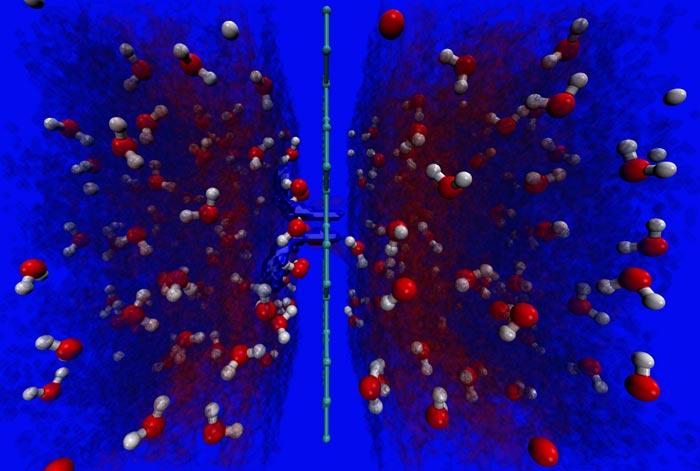Graphene Membrane Could Lead to Better Fuel Cells, Water Filters

Murali Raju, Penn State A figure showing the proton transfer channel across a quad-defect in graphene, as obtained from a ReaxFF molecular dynamics simulation.
The team, led by Franz Geiger of Northwestern University, tested the possibility of using graphene, the robust single atomic layer of carbon, as a separation membrane in water and found that naturally occurring defects, essentially a few missing carbon atoms, allowed hydrogen protons to cross the barrier at unprecedented speeds.
Whereas many researchers strive to make graphene defect-free in order to exploit its superior electronic properties, Geiger’s team found that graphene required the vacancies in order to create water channels through the membrane.
Computer simulations carried out at Penn State and the University of Minnesota showed the protons were shuttled across the barrier via hydroxyl-terminated atomic defects, that is, by oxygen hydrogen groups linked at the defect.
The paper, titled “Aqueous proton transfer across single-layer graphene,” will be published March 17 in the journal Nature Communications.
“Our simulations and experiments showed that you need to have at least four carbon vacancies and some sort of channel to overcome the energy barrier that would normally prevent the protons from crossing to the other side,” says Adri van Duin, associate professor of mechanical and nuclear engineering at Penn State, who used reactive force field calculations to do dynamical, atomistic scale simulations of the process.
“If we can learn how to engineer the defects and the defect size, we could make an effective separation membrane. Although it still requires a lot of design work, clearly this looks highly attractive for many applications, including desalinization.”
It may also work for a new, less complicated design for fuel cells in the future, Geiger believes. “All you need is slightly imperfect single-layer graphene,” he says.
Penn State co-authors are former Ph.D. student Muralikrishna Raju, now a post-doc at Stanford, post-doc Weiwei Zhang and van Duin.
Other co-authors include Oak Ridge National Laboratory’s Raymond Unocic, Robert Sacci, Ivan Vlassiouk, Pasquale Fulvio, Panchapakesan Ganesh, David Wesolowski and Sheng Dai; Northwestern University’s Jennifer Achtyl and Geiger; and University of Virginia’s Lijun Xu, Yu Cai and Matthew Neurock (all three now at the University of Minnesota).
This work was supported by the FIRST Center, an EFRC funded by the US Department of Energy, Office of Science, Office of Basic Energy Sciences. Microscopy was conducted as part of a user proposal at the Center for Nanophase Materials Sciences, an Office of Science User Facility at ORNL.
For a video simulation of the transport process, visit
https://www.youtube.com/watch?v=of-tmv05vw0&feature=youtu.be
Contact Information
Walter Mills
Associate Editor Publications
wem12@psu.edu
Phone: 814-865-0285
Media Contact
All latest news from the category: Materials Sciences
Materials management deals with the research, development, manufacturing and processing of raw and industrial materials. Key aspects here are biological and medical issues, which play an increasingly important role in this field.
innovations-report offers in-depth articles related to the development and application of materials and the structure and properties of new materials.
Newest articles

High-energy-density aqueous battery based on halogen multi-electron transfer
Traditional non-aqueous lithium-ion batteries have a high energy density, but their safety is compromised due to the flammable organic electrolytes they utilize. Aqueous batteries use water as the solvent for…

First-ever combined heart pump and pig kidney transplant
…gives new hope to patient with terminal illness. Surgeons at NYU Langone Health performed the first-ever combined mechanical heart pump and gene-edited pig kidney transplant surgery in a 54-year-old woman…

Biophysics: Testing how well biomarkers work
LMU researchers have developed a method to determine how reliably target proteins can be labeled using super-resolution fluorescence microscopy. Modern microscopy techniques make it possible to examine the inner workings…





















